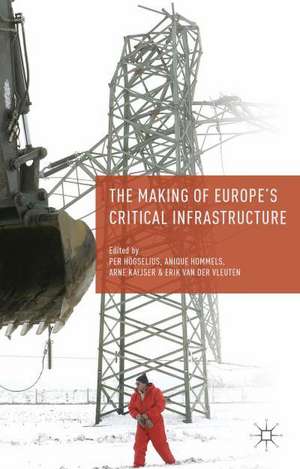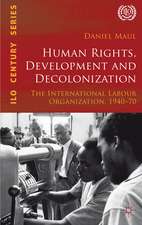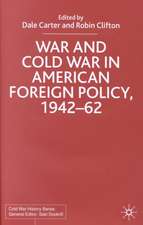The Making of Europe's Critical Infrastructure: Common Connections and Shared Vulnerabilities
Editat de P. Högselius, A. Hommels, A. Kaijser, E. van der Vleuten, Kenneth A. Loparoen Limba Engleză Hardback – 27 noi 2013
| Toate formatele și edițiile | Preț | Express |
|---|---|---|
| Paperback (1) | 383.18 lei 6-8 săpt. | |
| Palgrave Macmillan UK – 27 noi 2013 | 383.18 lei 6-8 săpt. | |
| Hardback (1) | 392.61 lei 6-8 săpt. | |
| Palgrave Macmillan UK – 27 noi 2013 | 392.61 lei 6-8 săpt. |
Preț: 392.61 lei
Nou
Puncte Express: 589
Preț estimativ în valută:
75.17€ • 78.28$ • 62.37£
75.17€ • 78.28$ • 62.37£
Carte tipărită la comandă
Livrare economică 13-27 februarie
Preluare comenzi: 021 569.72.76
Specificații
ISBN-13: 9781137358721
ISBN-10: 1137358726
Pagini: 313
Ilustrații: VIII, 313 p.
Dimensiuni: 155 x 235 x 25 mm
Greutate: 0.68 kg
Ediția:2013
Editura: Palgrave Macmillan UK
Colecția Palgrave Macmillan
Locul publicării:London, United Kingdom
ISBN-10: 1137358726
Pagini: 313
Ilustrații: VIII, 313 p.
Dimensiuni: 155 x 235 x 25 mm
Greutate: 0.68 kg
Ediția:2013
Editura: Palgrave Macmillan UK
Colecția Palgrave Macmillan
Locul publicării:London, United Kingdom
Cuprins
General Introduction
1. Europe's Critical Infrastructure and its Vulnerabilities: Promises, Problems, Paradoxes; Erik van der Vleuten, Per Högselius, Anique Hommels and Arne Kaijser
PART I: CONNECTING A CONTINENT
Introduction
2. Natural Gas in Cold War Europe: The Making of a Critical Infrastructure; Per Högselius, Anna Åberg, and Arne Kaijser
3. Inventing Electrical Europe: Interdependencies, Borders, Vulnerabilities; Vincent Lagendijk and Erik van der Vleuten
PART II: NEGOTIATING NEIGHBOURS
Introduction
4. An Uneasy Alliance: Negotiating Infrastructures at the Finnish-Soviet Border; Karl-Erik Michelsen
5. Bulgarian Power Relations: The Making of a Balkan Power Hub; Ivan Tchalakov, Tihomir Mitev and Ivaylo Hristov
6. Border-Crossing Electrons: Critical Energy Flows to and from Greece; Aristotle Tympas, Stathis Arapostathis, Katerina Vlantoni and Yiannis Garyfallos
PART III: COPING WITH COMPLEXITY
Introduction
7. EUROCONTROL: Negotiating Transnational Air Transportation in Europe; Lars Heide
8. Connections, Criticality, and Complexity: Norwegian Electricity in its European Context; Lars Thue
9. In Case of Breakdown: Dreams and Dilemmas of a Common European Standard for Emergency Communication; Anique Hommels and Eefje Cleophas
Conclusion
10. Europe's Infrastructure Vulnerabilities: Comparisons and Connections; Anique Hommels, Per Högselius, Arne Kaijser and Erik van derVleuten
Bibliography
Index
1. Europe's Critical Infrastructure and its Vulnerabilities: Promises, Problems, Paradoxes; Erik van der Vleuten, Per Högselius, Anique Hommels and Arne Kaijser
PART I: CONNECTING A CONTINENT
Introduction
2. Natural Gas in Cold War Europe: The Making of a Critical Infrastructure; Per Högselius, Anna Åberg, and Arne Kaijser
3. Inventing Electrical Europe: Interdependencies, Borders, Vulnerabilities; Vincent Lagendijk and Erik van der Vleuten
PART II: NEGOTIATING NEIGHBOURS
Introduction
4. An Uneasy Alliance: Negotiating Infrastructures at the Finnish-Soviet Border; Karl-Erik Michelsen
5. Bulgarian Power Relations: The Making of a Balkan Power Hub; Ivan Tchalakov, Tihomir Mitev and Ivaylo Hristov
6. Border-Crossing Electrons: Critical Energy Flows to and from Greece; Aristotle Tympas, Stathis Arapostathis, Katerina Vlantoni and Yiannis Garyfallos
PART III: COPING WITH COMPLEXITY
Introduction
7. EUROCONTROL: Negotiating Transnational Air Transportation in Europe; Lars Heide
8. Connections, Criticality, and Complexity: Norwegian Electricity in its European Context; Lars Thue
9. In Case of Breakdown: Dreams and Dilemmas of a Common European Standard for Emergency Communication; Anique Hommels and Eefje Cleophas
Conclusion
10. Europe's Infrastructure Vulnerabilities: Comparisons and Connections; Anique Hommels, Per Högselius, Arne Kaijser and Erik van derVleuten
Bibliography
Index
Recenzii
“Each chapter presents a wealth of information thatsheds fascinating light on a crucial yet understudied field. One learns a lotfrom delving into the empirically rich chapters that pave the way for futureresearch. … the book deals with a very important yet widely under-researchedtopic. It is highly relevant for EU scholars working in the fields of energy,telecommunications and air transport, as well as foreign and security policy.” (PeterSlominski, Journal of Common Market Studies, Vol. 53 (5), 2015)
Notă biografică
Per Högselius is Associate Professor at the Division of History of Science, Technology and Environment at the Royal Institute of Technology (KTH), Stockholm, Sweden. His research has focused on international aspects and in particular East-West relations in the history of science, technology, and environment. Most recently he published Red Gas: Russia and the Origins of European Energy Dependence (2013).
Anique Hommels is Associate Professor at the Science, Technology & Society (MUSTS) research group, Maastricht University, the Netherlands. She has previously published Unbuilding Cities: Obduracy in Urban Sociotechnical Change (2005). Her current research focuses on vulnerability in technological cultures, urban disasters, and standardization in emergency communication.
Arne Kaijser is Professor of History of Technology at the Royal Institute of Technology (KTH), Stockholm, Sweden. His main research interests concern infrastructure, institutions, and environment in historical perspective. Together with Erik van der Vleuten he edited Networking Europe: Transnational Infrastructures and the shaping of Europe, 1850-2000 (2006).
Erik van der Vleuten is Professor of History of Technology at Eindhoven University of Technology, the Netherlands, and scientific director of the Foundation for the History of Technology(SHT). In 2013-2015 he chaired the Pan-European research network Tensions of Europe: Technology and the Making of Europe. Erik studies the mutual shaping of infrastructure, societal, and environmental changes.
Anique Hommels is Associate Professor at the Science, Technology & Society (MUSTS) research group, Maastricht University, the Netherlands. She has previously published Unbuilding Cities: Obduracy in Urban Sociotechnical Change (2005). Her current research focuses on vulnerability in technological cultures, urban disasters, and standardization in emergency communication.
Arne Kaijser is Professor of History of Technology at the Royal Institute of Technology (KTH), Stockholm, Sweden. His main research interests concern infrastructure, institutions, and environment in historical perspective. Together with Erik van der Vleuten he edited Networking Europe: Transnational Infrastructures and the shaping of Europe, 1850-2000 (2006).
Erik van der Vleuten is Professor of History of Technology at Eindhoven University of Technology, the Netherlands, and scientific director of the Foundation for the History of Technology(SHT). In 2013-2015 he chaired the Pan-European research network Tensions of Europe: Technology and the Making of Europe. Erik studies the mutual shaping of infrastructure, societal, and environmental changes.
Textul de pe ultima copertă
Europe's critical infrastructure is a key concern to policymakers, NGOs, companies, and citizens today. A 2006 power line failure in northern Germany closed lights in Portugal in a matter of seconds. Several Russian-Ukrainian gas crises shocked politicians, entrepreneurs, and citizens thousands of kilometers away in Germany, France, and Italy. This book argues that present-day infrastructure vulnerabilities resulted from choices of infrastructure builders in the past. It inquires which, and whose, vulnerabilities they perceived, negotiated, prioritized, and inscribed in Europe's critical infrastructure. It does not take 'Europe' for granted, but actively investigates which countries and peoples were historically connected in joint interdependency, and why. In short, this collection unravels the simultaneous historical shaping of infrastructure, common vulnerabilities, and Europe.
Caracteristici
Topic: Critical infrastructure belongs to the most pressing policy issues of the 21st century. Failures in such infrastructure put companies, administrations, and citizens at risk. Because of these new vulnerabilities and risks, Critical Infrastructure has become a major concern for policy makers, companies, NGO's, and scholars in North America, Europe and elsewhere in the world. In the 2000s the E.U. and its Member States have put elaborate Critical Infrastructure Protection (CIP) programs in place, and critical infrastructure became a field of academic inquiry. Critical Infrastructure Protection today is a leading EU policy domain Historical approach: Presentday policy and academic CI studies tend to take the emergence of infrastructure and its vulnerabilities for granted, or vaguely blame them on 'globalization'. They are in urgent need of historical contextualization. The book studies the emergence and governance of critical infrastructure and its vulnerabilities as a historical process. We show, for the first time, that Europe's presentday infrastructure and its vulnerabilities stem from concrete historical processes, choices, and power games (mainly post194, in which historical agents interpreted, negotiated, and prioritized some infrastructure connections and vulnerabilities at the expense of others. Even the very interpretation of infrastructure as 'risky' or 'reliable' was subject to disagreement, conflict, and historical change. These historical processes frame present day perceptions of critical infrastructure vulnerability. Policy makers and academics need to be aware of this historical legacy in order to transcend it (rather than unknowingly reproducing it) Transnational approach: Prominent critical infrastructure scholars argue that Europe's presentday vulnerabilities reside precisely in their crossborder character. And yet, CI studies have overwhelmingly focused on national infrastructure issues (and to some extent the EU critical infrastructure policy process). They by and large failed to critically examine the transnational dynamics and spatial distribution of infrastructure vulnerabilities: Who was connected in joint vulnerability to whom and why? This book fills the gap Active investigation of Europe: Those CI studies that do address crossborder risks take 'Europe' as a given, which they unreflexively equate with presentday EU territory and governance: They presuppose EU territory as their selfevident unit of analysis, and EU governance as the 'natural' agent to handle such risks. By contrast, this book does not take 'Europe' as a given but actively investigates how the very shaping of 'Europe' entwined with the shaping of critical infrastructure. We link up to new transnational history interpretations of Europe, which avoid interpreting Europe as a teleological integration story that naturally ends with the EU version of European integration. In particular we follow the body of scholarship that studies Europe's 'hidden' (Misa and Schot 200 integration and fragmentation processes in the spheres of science, technology, and enterprise. We inquire how transnational critical infrastructure and its risks produced particular forms of European integration and fragmentation in an openended process, in which EU borders and governance were/are just one out of several options next to other forms of international or decentralized organization












